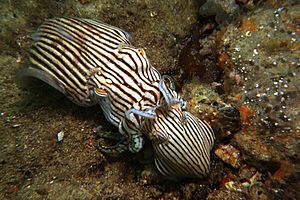Sepioloidea lineolata facts for kids
Quick facts for kids Sepioloidea lineolata |
|
|---|---|
 |
|
| Conservation status | |
| Scientific classification | |
| Synonyms | |
|
The striped pyjama squid (also called the striped dumpling squid) is a small, colorful creature. It is a type of cuttlefish that lives in the Indo-Pacific Oceans near Australia. This squid makes its home on the ocean floor. It is both venomous and poisonous, which helps it stay safe. When fully grown, a striped pyjama squid is only about 7 to 8 centimeters long. That's about the size of a small cell phone!
Contents
Body Features of the Striped Pyjama Squid
The striped pyjama squid is a type of cuttlefish, so it can change its look. It can turn a dark brown or purple color. This helps it hide from danger or blend in with its surroundings.
This squid has two special tentacles for eating. It also has eight arms. Its body is small and rounded. The two feeding tentacles have suckers with tiny teeth around their edges. These help the squid grab its food.
How the Striped Pyjama Squid Protects Itself
The striped pyjama squid has glands under its body. These glands can release a toxic slime when the squid feels threatened. This slime contains many different proteins and toxins. The slime helps scare off predators. It also gives the squid enough time to escape.
Another way the striped pyjama squid protects itself is by releasing ink. The ink that these animals make comes from two different glands. It gets its dark color from something called melanin. When the squid shoots out ink, it can look like the squid itself. This tricks predators, giving the squid a chance to swim away. The ink can also make it hard for predators to see.
The striped pyjama squid has white and brown stripes all over its body. The white stripes reflect light. The dark stripes are made of tiny sacs of color called chromatophores. The squid can flash these dark stripes. Like some other similar animals, the striped pyjama squid is poisonous. Its saliva contains a strong toxin called tetrodotoxin. This toxin affects the nervous system.
What the Striped Pyjama Squid Eats
The striped pyjama squid is a predator. This means it hunts and eats other animals. It likes to eat fish, shrimp, and other small crustaceans.
During the day, the Sepioloidea lineolata buries itself in the sand. Only the top of its head and its yellow eye are visible. The squid keeps flicking sand over its body to stay hidden. Because it is almost always buried, its eye is placed on the top of its head. This also means the striped pyjama squid has many light-sensing cells in its eyes. This helps it see well even with limited movement.
Parasites of the Striped Pyjama Squid
Sometimes, the striped pyjama squid can have tiny worm-like parasites called dicyemids. These parasites affect the kidney-like parts of cephalopods that live on the seafloor. Dicyemids usually only live in specific types of hosts. They can live well inside the striped pyjama squid because its kidney-like parts are filled with fluid. This creates a good home for the parasite. Once inside, the dicyemid gets its food from the squid's waste.
Reproduction and Life Cycle
Striped pyjama squids reproduce sexually. To mate, a male squid will grab a female squid. They position themselves head-to-head. The male then places a sperm packet (called a spermatophore) near where the female will store the sperm. She keeps the sperm until she is ready to lay eggs.
A male Sepioloidea lineolata can also remove sperm left by another male. He uses a special spoon-shaped arm to do this. Like many species of cuttlefish, the male usually dies after mating. The females lay their eggs soon after mating. They lay their eggs in groups or clumps. They often place them under coral on the seafloor.


